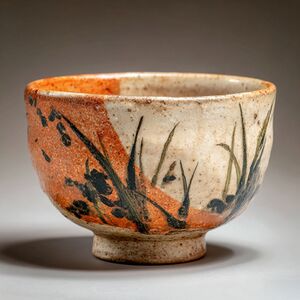E-Shino

E-Shino is a subtype of Shino ware that originated in the Mino Province kilns (present-day Gifu Prefecture) during the late Momoyama period (late 16th century). It is distinguished by its iron-oxide painted decoration under a thick white feldspar glaze.
History
E-Shino developed as one of the earliest Japanese ceramics to combine painted decoration with a feldspar glaze. The motifs, painted in iron-oxide slip, often depicted seasonal grasses, flowers, and abstract patterns inspired by Japanese aesthetics. The style became popular among tea ceremony practitioners for its warm, rustic charm.
Characteristics
E-Shino is known for:
- Iron-oxide brushwork applied directly onto the clay body before glazing.
- Thick white feldspar glaze (志野釉, Shino-yū) covering the painted designs, resulting in a softened, blurred effect.
- Motifs including pampas grass, plum blossoms, bamboo, and geometric patterns.
- Color variations from pure white to pale orange, depending on kiln atmosphere.
Cultural significance
E-Shino pieces capture a balance between artistic decoration and the natural, irregular effects of kiln firing. This made them particularly suited to the Japanese tea ceremony, where subtle imperfection and organic beauty were valued.
Modern production
Today E-Shino is still produced in Gifu Prefecture and by contemporary potters across Japan. Artists often reinterpret traditional motifs or experiment with new subjects while preserving the signature white glaze and iron-oxide painting.
See also
External links
- Tajimi Tourism Association (in Japanese)